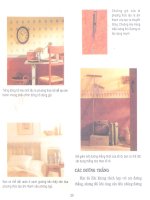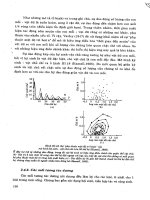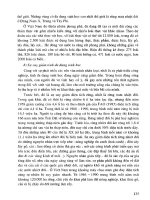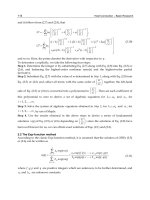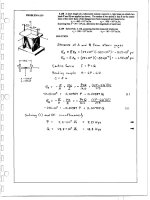Materials Selection Deskbook 2011 Part 6 potx
Bạn đang xem bản rút gọn của tài liệu. Xem và tải ngay bản đầy đủ của tài liệu tại đây (277.77 KB, 15 trang )
Properties and Selection of Materials
63
content to about 1.5% the yield point can be increased up to 400 N/mm2.
Tlus provides better retention of strength at elevated temperatures and
better toughness at low temperatures.
3.4.2 Corrosion Resistance
Equipment from mild steel usually is suitable for handling organic
solvents, with the exception of those that are chlorinated, cold alkaline
solutions (even when concentrated), sulfuric acid at concentrations greater
than 88% and nitric acid at concentrations greater than 65% at ambient
temperatures [7].
Mild steels are rapidly corroded by mineral acids even when they are very
dilute (pH less than 5. However, it is often more economical to use mild
)
steel and include a considerable corrosion allowance on the thickness of the
apparatus. Mild steel is not acceptable in situations in which metallic
contamination of the product is not permissible.
3.4.3 Heat Resistance
The maximum temperature at which mild steel can be used is 550°C.
Above this temperature the formation of iron oxides and rapid scaling
makes the use of mild steels uneconomical. For equipment subjected to high
loadings a t elevated temperatures, it is not economical to use carbon steel in
cases above 450°C because of its poor creep strength. (Creep strength is
time-dependent, with strain occurring under stress.)
3.4.4 Low Temperatures
At temperatures below 10°C the mild steels may lose ductility, causing
failure by brittle fracture at points of stress concentrations (especially a t
welds) [8,9]. The temperatures at which the transition occurs from ductile to
brittle fraction depends not only on the steel composition, but also on
thickness.
Stress relieving at 600-7OO'C for steels decreases operation at temperatures
some 20°C lower. Unfortunately, suitable furnaces generally are not
available, and local stress relieving of welds, etc., is often not successful
because further stresses develop on cooling.
3.4.5 High-Carbon Steels
Highcarbon steels containing more than 0.3% are difficult to weld, and
nearly all production of this steel is as bar and forgings for such items as
shafts, bolts, etc. These items can be fabricated without welding. These steels
64
Materials Selection Deskbook
are heat treated by quenching and tempering to obtain optimum properties
up to 1000 N/mm* tensile strength.
3.4.6 Low-Carbon, Low-Alloy Steels
Low-carbon, low-alloy steels are in widespread use for fabrication-welded
and forged-pressure vessels. The carbon content of these steels is usually
below 0.2%, and the alloying elements that do not exceed 12% are nickel,
chromium, molybdenum, vanadium, boron and copper. The principal
applications of these steels are given in Table 3.8.
3.4.7 Mechanical Properties
The maximum permissible loading of low-alloy steels according to the
ASME code for pressure vessels is based on proof stress (or yield point),
which is applicably superior to those of carbon steels. The cost of a
pressure vessel in alloy steel may be more expensive than in carbon steel.
However, consideration should be given to other cost savings resulting from
thinner-walled vessels, which provide fabrication savings on weldings, stress
relieving, transportation, erection and foundation. Table 3.9 compares mildand low-alloy steels used for fabricating spherical gas storage tanks.
3.4.8 Corrosion Resistance
The corrosion resistance of low-alloy steels is not significantly better than
that of mild steel for aqueous solutions of acids, salts, etc. The addition of
0.5% copper forms a rust-colored film preventing further steel deterioration;
small amounts of chromium (1%) and nickel (0.5%) increase the rust
Table 3.8. Applications of Low-Carbon, Low-Alloy Steels [ 10)
~
0.5 Mo
1.25 CrMo
2.25 CrMo
6 to 12 CrMoVW
High creep strength for:
1 . pressure vessels such as boilers operating
at elevated temperatures; and
2. oil refinery vessels such as crackers and
reformers with high hydrogen pressures.
5 to 9%Cr
tor oil refinery applications involving
high-sulfur process streams, e.g., pipe stills.
CuCr (Corten)
Rust-resisting steels for structural
applications.
2 to 9%Ni
I:or cryogenic applications.
65
Properties and Selection of Materials
Table 3.9. Comparison o f Mild and Low-Alloy Quenched and Tempered Steels [ 1 I la
Low-Alloy
Steel, a
~
~~
Low-Alloy
Steel, b
Mild Steel
~~~
Relative t01;il weight o f
other steel rcquircd tor
supporting structures, c t c .
Diarnctcr of vcsscls, (in)
Capacity of cacli vessel, (in')
Shcll thickness, (mm)
1
1.35
1
2
39
30,000
35
31
15,000
37
3.2
20
14
1500
35
"Steel a
WJS quenched and tcnipercd to a tensile, strength of 830 N/mm2 and a yield
strength of 670 N/riiin2, and steel b to 620 and 4 5 0 N/nirn2, rcspcctively. I t was considered that thc maximum thickness of metal that could be welded onsite was 38 inm.
resistance of copper steels still further. Low alloy steels have good resistance
to corrosion by crude oils containing sulfur. This is illustrated by the data in
Figure 3.3.
In operations involving hydrogen at partial pressures greater than 35
kgf/cm* and temperatures greater than 250"C, carbon steels are decarborized
and fissured internally by hydrogen [13]. Small additions of molybdenum
prevent hydrogen attack at temperatures up to 350°C and pressures up to
56 kgf/cm2. For higher temperatures and pressures chromium/molybdenum
steels (2.25 Cr, 0.5 Mo) are used. Figure 3.4 shows operating limits for steels
in atmospheres containing hydrogen.
3.4.9 Oxidation Resistance and Creep Strength
Chromium is the most effective alloying element for promoting resistance
to oxidation. Table 3.10 gives temperatures at which steels can be used in
air without excessive oxidation. In atmospheres contaminated with sulfur,
lower maximum temperatures are necessary.
In fractionation columns for petroleum products, where the oxygen
content is restricted, higher temperatures can be used without excessive
waste of the metal.
The creep strength of steels is a factor limiting the maximum temperatures
for such high-pressure equipment as shells and stirrers of high temperature
reactors. Table 3.10 presents creep data for temperatures ranging from
400 to 600°C. The stress for 1% creep in 100,000 hours (which is a design
criterion) is accepted to be not less than two-thirds of the creep stresses.
66
Materials Selection Deskbook
4.0
n
t
i
300
400
500
T E M P E R A T U R E ("C)
Figure 3.3. Effect of temperature on corrosion rates of steels in crude oil containing
sulfur [12].
I
I
I
I
600
1.25 Cr/O.SMo 2Cr/0.5
c
0
I
1
I
-
Mo
L
W
a
3
.F
400
a
a
W
n
=
W
200
I
-
I
I
I
I
I
I
300 600 900 1200 1500 1800 2100
HYDROGEN P A R T I A L PRESSURE ( N / c m 2 )
I
Figure 3.4.
Operating limits for steels in atmospheres containing hydrogen.
1
Properties and Selection of Materials
67
Table 3.10. Alloying Effects that Improve Creep Properties [ 14)
Stress for rupture, N/mm*, in 100,000 hr at
Steel
400°C
460°C
480°C
500%
560°C
580'c
Carbon (silicon-killed)
1% Cr Mo
21% Cr Mo
l 2 Cr M V
/%
o
12% Cr Mo V
180
75
48
27
145
168
185
215
40
70
70
52
81
IO
600°C
55
3.4.10 Low-Temperature Ductility
Nickel is the alloying element used for improving low-temperature
ductility. The addition of 1.5% nickel to 0.25% Cr/0.25% Mo steels provides
satisfactory application for moderately low temperatures down to about
-50°C.
Heat treatment by quenching and tempering improves the low temperature
ductility of steels such as 0 5 Cr, 0.5% Mo, 1% Ni Type V. For lower.
temperature application (below -196"C),up to 9% nickel is used as the sole
alloying element.
3.4.1 1 High-Carbon, Low-Alloy Steels
Highcarbon (about 0.4%), low-alloy steels that are not weldable usually
are produced as bars and forging for such items as shafting, high-temperature
bolts and gears and ball bearing components. These steels can be less
drastically quenched and tempered to obtain tensile strengths of at least
1500 N/mm2, thus minimizing the danger of cracking [ 151.
3.5 PROPERTIES O F HIGH-ALLOYSTEELS
Stainless and heat-resisting steels containing at least 18% by weight
chromium and 8% nickel are in widespread use in industry. The structure of
these steels is changed from magnetic body centered cubic or ferritic crystal
structure to a nonmagnetic, facecentered cubic or austenitic crystal
structure.
68
Materials Selection Deskbook
3.5.1 Chromium Steels (400 Series), Low-Carbon
Ferritic (Type 405): 12-13% Chromium
The main use of this type steel is for situations in which the process
material may not be corrosive to mild steel, yet contamination due to rusting
is not tolerable and temperatures or conditions are unsuitable for aluminum.
However, prolonged use of these steels in the temperature range of 450 to
550°C causes low-temperature embrittlement of most ferritic steels with more
than 12% chromium [ 161.
3.5.2 Medium Carbon Martensitic: 13- 17% Chromium
(Types 403,410,414,416,420,431,440)
These steels resist oxidation scaling up to 825°C but are difficult to weld
and, thus, are used mainly for items that d o not involve welded joints [17].
They are thermally hardened and useful for items that require cutting edges
and abrasion resistance in mildly corrosive situations. However, they should
not be tempered in the temperature range of 450 to 650°C.
This reduces the
hardness and wear resistance and also lowers the corrosion resistance because
of the depletion of chromium in solution through the formation of chromium
carbides.
3.5.3 Medium Carbon Ferritic: 17-30% Chromium (Types 430 and 446)
The 17% ferritic steels are easier to fabricate than the martensitic grades.
They are used extensively in equipment for nitric acid production. The
oxygen- and sulfur-resistant 30% chromium steel can be used at temperatures
up to 1150°C but only for lightly loaded and well-supported furnace items
because of its poor creep and brittlement properties when equipment is
down to ambient temperatures [18].
3.5.4 Chromium/Nickel Austenitic Steels (300 Series)
The excellent corrosion resistance over a wide range of operating conditions
and readily available methods of fabrication by welding and other means of
shaping metals make these steels the most extensively used throughout the
chemical and allied industries.
The formation of a layer of metal oxide on the surface of this steel
provides better corrosion resistance in oxidizing environments than under
reducing conditions. Common steels 304, 304L, 347, 316 and 316L are
used for equipment exposed to aqueous solutions of acids and other lowtemperature corrosive conditions. For high-temperature regimes involving
i
&
'J
0
E
.E
8
3
9
00000
v.?88
Properties and Selection of Materials
000
999
222
z!y .. ..
..
sss
9999
0000
-4d-d-m
6666
4 - 3 4
9999
moo-
N 4 4 4
6 6 0 7':
00
'?9999
0
9
000
- 4 4
- 4 4 4
000
00000
999
4 4 - 4 4
29 90
009
"
4 - 4 4 -
00000
9 9 9 9 9 999""
md-wmm
0
9
T
3 0 0 0 0
39999
+-4-w
c?=?zz 22:
0000
00000
NNNNN
99999
00000
y??ZZ
o m m w
00000
9 " 9 N 9
m m m m ~
w
??99?
00000
mmm
-Pw
Wd-d-
b W W P
A
mmmm
V J V J
m m m o o
000--.
mmmmm
2
E"
0
N
69
70
*
c:
0
";;
"~
O
Q.
E
o
..
]
"E
"
.:
u
:(J
=
41
e
41
~
~
""
z
..
u
,~
.e
..
~
i..
fi}
.~
"'
00
..°
O
..
~~Z
O
M
9
o
0
~
;<
~
0
c=
oV)
~00
"0
00
'e
0
"'
N
E
0
'r)
M
.;,
~
~~
.;,
"!
,(,(,(
cucucu
E E E
""""'
000
o o o
~~~
N-i...;-0-0-o
>-M\Dr-a-
00
NMM't"t"t'
't"t"t"t"t"t'
~~~~~~
<~u
000
-ioO..:oOoOoO
, , , .,
00000000000
0"""00000000
'.;'.;'.;-i-i
.,
, , .,
00000000000
""""'00000000
..;..;..;NN
...:...:...:...:...:...:
"'
-0;
"
rn
00000000000
."0000000000
0...:...:...:...:
000000
0;0;0;0;0;0;
0000
"'1000
-oiaciaci~
---N
..-L
0000
"'1000
...:-oi-oiM
---N
000."."
0;0;0;~~
."x
'.:."."0
-,,",,"r-a-M
OEEOO..;
tMOOJ,J,
.~
.v;
c
"
~
~
~
xxx'.:x
""""""""""
EEEEE
."."."."."
0000
0;0;0;0;
oV)V)o
C!"!"!"?
00000000000
.,
(/]
..: ..: ,( ..:
cucucucu
e e e e
fX>MMO
tL.~
...'00\0
oMMv
vvvv
tL.~tL.~
MO't'\0\O
0
't"t"t"t"t'
~~~~~
O--M
0000
.
,( ..
~ I: ~
e .e 1
°
-0.'.'.,.,
('I.
Materials Selection Deskbook
~
..
=
.5
c
o
"
..;
..
~
~
.s
(;5
--~
e
'-'
c
~
{,)
=
"'
"' "'
Q..O
>.e
f-o=
Properties and Selection of Materials
71
oxidation, carborization, etc., the 309 and 310 compositions may be
recommended because of their higher chromium content and, thus, better
resistance to oxidation [20].
Type 304- 19110 (chromium nickel) provides a stable austenitic structure
under all conditions of fabrication. Carbon (0.08% max.) is sufficient to have
reasonable corrosion resistance without subsequent corrosion resistance
for welded joints. Type 304 is used for food, dairy and brewery equipment,
and for chemical plants of moderate corrosive duties.
Type 304L-This is used for applications involving the welding of plates
thicker than about 6.5 mm.
Type 321-This is an 18/10 steel that is stabilized with titanium to
prevent weld decay or intergranular corrosion. It has similar corrosion
resistance to types 304 and 304L but a slightly tugher strength than 304L;
also, it is more advantageous for use at elevated temperatures than 304L.
Type 347-This is an 18/11 steel that is stabilized with niobium for
welding. In nitric acid it is better than Type 321; otherwise, it has
similar corrosion resistance.
Type 316-This has a composition of 17/ 12/2.5 chromium/nickel/molybdenum. The addition of molybdenum greatly improves the resistance
to reducing conditions such as dilute sulfuric acid solutions and solutions
containing halides (such as brine and sea water).
Type 316L-This is the lowcarbon (0.03%m a . ) version of type 316 that
should be used where the heat input during fabrication exceeds the
incubation period of the 316 (0.08% carbon) grade. For example, it is used
for welding plates thicker than 1 cm.
Type 309-This is a 23/14 steel with greater oxidation resistance than
18/10 steels because of its higher chromium content.
Type 315-This has a composition that provides a similar oxidation
resistance to type 309 but has less liability to embrittlement due to sigma
formation if used for long periods in the range of 425 to 815°C. (Sigma phase
is the hard and brittle intermetallic compound FeCr formed in chromium
rich alloys when used for long periods in the temperature range of 650 to
SSO".)
Alloy 20-This has a composition of 20% chromium, 25% nickel, 4%
molybdenum and 2% copper. This steel is superior to type 316 for
severely reducing solutions such as hot, dilute sulfuric acid.
3.5.5 Precipitation Hardening Stainless Steels
These steels do not have AIS1 numbers and are referred to by trade
name. Examples are given in Table 3.12. They can be heat-treated to give the
following mechanical properties:
Materials Selection Deskbook
72
Ultimate tensile strength, 1235 N/mrn2
0.2%proof stress, 1080 N/mm2
Elongation, 10%
Hardness, 400 DHN
0
0
0
Properties are higher than those of austenitic steels and they retain a
general level of corrosion resistance considerably better than that of
chromium martensitic steels. They can be supplied as forgings, castings, plate,
bar and sheets and can be readily welded and formed before hardening. A
typical application is for gears in pumps used for metering chemicals where
their hardness prevents wear and galling in contact with Type 316 bodies.
3.5.6 Chromium/Nickel/Ferrite/Austenite
Steels
These steels also are not yet included in the AIS1 system. Trade names
and typical compositions are given in Table 3.13. These steels can be welded
successfully because they are not predisposed to excess grain growth at
elevated temperatures. However, the general level of their corrosion resistance
is usually inferior to that of austenitic steels, although they have good
resistance to stress corrosion cracking. For example, using austenitic steels in
hot, slightly acid solutions containing chlorides causes rapid cracking in a few
weeks, whereas the ferritelaustenite steels may last many years.
Table 3.1 2. Examples of Precipitation Hardening Stainless Steels
Composition, %
Name
C
Si
Mn
Cr
Ni
M
o
Cu
AI
N2
Armco 1717 PH
Armco 14/8 PH-Mo
Allegheny Ludlum AM350
Allcgheny Ludlum AM355
Firth Vickers 520(S)
0.07
0.03
0.09
0.13
0.3
0.3
0.5
0.25
0.3
0.6
0.6
1.0
1.0
1.0
17.0
14.5
17.5
15.5
16.0
7.0
8.5
4.2
4.2
5.5
-
-
1.2
1.2
-
-
2.5
2.75
2.75
1.75
~~
0.05
2.0
-
0.1
0.1
-
Table 3.1 3. Compositions of FerritejAustenite Stainless Steels
Composition (% wt)
~
~~~~
Name
C
Si
Mn
Cr
Ni
M
o
Nb
Firth Vickers 702
Sandvik 3RE60
Lanelev I..erralium
0.02
0.02
0.5
1.6
0.6
15.7
18.5
25
2.5
4.7
1.0
2.7
1.5
0.5
5
Cu
2
Properties and Selection of Materials
73
3.5.7 Maraging Steels
For corrosion resistance, these steels (18% nickel, 9% cobalt, 3% molybdenum, 0.2% titanium and 0.02% carbon) are similar to the 13% chromium
steels and, therefore, are suitable for mildly corrosive situations. Because of
their very high strength after heat treatment (yield strength-1 390 N/mm2,
elongation-l5%, impact strength) maraging steels find some use in a very
high-pressure equipment.
3.6 APPLICATIONS OF HIGH-ALLOY STEELS
With austenitic stainless steels a high carbon content may cause the
formation of chromium carbides at grain boundaries, consequently producing
intergranular corrosion. This is most likely to occur during welding (called
“weld decay”). This phenomenon may be avoided by using either a lowcarbon steel (grade L) (Le., less than 0.03% carbon), or a steel containing
titanium or niobium, such as Types 321 and 347.
Intergranular corrosion depends on the length of time the steel is
exposed to the sensitizing temperature (500-75OoC), even if made from
lowcarbon or titanium- or niobium-stabilized steel.
Equipment fabricated from such a steel may undergo corrosion by
condensation of even mild corrosives unless it is possible to keep it above
the dew-point or to neutralize acidic condensates. This kind of corrosion
can be prevented by a preliminary heat-treating at temperatures of 81591 5°C.The niobium-stabilized steels respond best to this treatment.
Stress corrosion cracking, usually occurring at temperatures above 8OoC,
takes place in equipment made from austenitic stainless steel but does not
affect ferritic steels in this way. Stress cracking most often occurs in
solutions of chlorides. Concentrations of a few parts per million can cause
severe cracking, even in a medium that would not be considered corrosive,
for example in water main lines. Stress corrosion cracking can be caused by
some thermal insulating materials, but can be prevented by cladding the
insulation with aluminum. This eliminates rain from washing chlorides into
contact with the steel.
Residual stresses occur from welding and other fabrication techniques
even at very low stress values. Unfortunately, stress relief of equipment is
not usually a reliable or practical solution. Careful design of equipment can
eliminate crevices or splash zones in which chlorides can concentrate. The
use of high-nickel stainless steel alloy 825 (40% nickel, 21% chromium,
3% molybdenum and 2% copper) or the ferritic/austenitic steels would
solve this problem.
74
Materials Selection Deskbook
3 6 1 Oxidation Resistance
..
The ferritic chromium steels (chromium is the principal alloying element)
are the most economical for very lightly loaded high-temperature situations.
However, they are inadequate when creep must be accounted for. Austenitic
steels are often recommended for such conditions. The 17% chromium
0';
alloys (Type 430) resist scaling up to 8 0 C and 25% alloy (Type 446)up to
1100°C [21].
3.6.2 Mechanical Properties at Elevated Temperatures
The austenitic steels containing nickel are used for load-bearing applications, pressure vessels operating above 550"C, well as for light-load cyclic
as
operation because they have a more adherent scale than chromium steels
and generally do not become brittle under high-temperature service. The
18/10 alloys are suitable for use up t o 800°C in air; the 25/10 Type 310
alloys are suitable for use up to 1100°C.
When using Type 316 alloy at high
temperatures, care should be taken that the atmosphere is not stagnant as
catastrophic oxidation of molybdenum may occur.
For high-pressure, high-temperature situations where steels are required
with certified creep strength properties, the AIS1 austenitic steels are given
the suffix H (e.g., 3478,316Hetc.).
Below creep range temperatures, economies can be made by using
nitrogencontaining (for example BS1501 Part 6, Grades 304865 and
3 16866) or worm-worked grades, as these have higher proof strength
than ordinary grades [22].
3.6.3 Mechanical Properties at Low Temperatures
The austenitic steels can be used at very low temperatures (low-alloy
ferritic steels containing 9% nickel down to -196°C) without the risk of
brittle fracture [23].
3.7 CORROSION-RESISTANT NICKEL AND NICKEL ALLOYS
Nickel alloys have two main properties: good resistance to corrosion and
high-temperature strength. There are alloys for medium- and low-temperature
applications and for high-temperature conditions in which creep resistance is
of main importance [24].
The standard quality of commercially pure nickel (nickel 99% minimum,
carbon 0.15% maximum; nickel 200/201) can be readily welded and
fabricated in all wrought forms and as castings. However, it is restricted t o
Properties and Selection of Materials
75
special applications for which nickel alloys are not adequate (for example, for
equipment used in the production of caustic soda where it is not subject to
stress corrosion cracking in hot caustic soda solutions) [25,26].
Unalloyed nickel is used where it is necessary to eliminate iron and copper
contamination (nickel 200 up to 300°C and nickel 201 above 300°C).
3.7.1 Nickel/Copper (Alloy 400)
Alloy 400 has good mechanical properties and is easy to fabricate in all
wrought forms and castings. K-500 is a modified version of this alloy and
can be thermally treated and is suitable for items requiring strength, as well as
corrosion resistance. Alloy 400 has immunity to stress corrosion cracking and
pitting in chlorides and caustic alkali solutions.
Alloy 400 is also adequate for equipment processing of dry halogen
gases and chlorinated hydrocarbons and can be used in reducing environments.
3.7.2 Nickel/Molybdenum
This alloy has a nominal composition of 65% nickel, 28% molybdenum
and 6% iron. It is generally used in reducing conditions. It is intended to
work in very severely corrosive situations after post-weld heat treatment to
prevent intergranular corrosion. These alloys have outstanding resistance to
all concentrations of hydrochloric acid up to boiling-point temperatures and
in boiling sulfuric acid solutions up to 60% concentration.
3.7.3 Nickel/Molybdenum/Chomium
The composition of this alloy (54% nickel, 15% molybdenum, 15%
chromium, 5% tungsten and 5% iron) is less susceptible to intergranular
corrosion at welds. The presence of chromium in this alloy gives it better
resistance to oxidizing conditions than the nickel/molybdenum alloy,
particularly for durability in wet chlorine and concentrated hypochlorite
solutions, and has many applications in chlorination processes. In cases in
which hydrochloric and sulfuric acid solutions contain oxidizing agents such
as ferric and cupric ions, it is better to use the nickel/molybdenum/
chromium alloy than the nickel/molybdenum alloy.
3.7.4 Nickel/Chromium/Molybdenum/Iron
Because the composition of this alloy (47% nickel, 22% chromium, 7%
molybdenum and 17% iron) has a higher iron content it cannot withstand
such aggressive corrosion conditions as nickeVmolybdenum and nickel/
Materials Selection Deskbook
76
molybdenum/chromium alloys. I t is, however, less expensive. The nickel
makes these alloys immune to stress corrosion cracking and also superior to
stainless steels with respect to pitting in chloride solutions. Because of
these properties, their greater cost over stainless steel is justified.
3.7.5 Nickel/Chromium/Molybdenumlcopper
These alloys (50/60% nickel, 20/30% chromium, 518% molybdenum, and
5/7% copper) have very good resistance to hot sulfuric acid solutions and
similar environments. They are only available as castings but can be
hardened by heat treatment. The castings are suitable for parts requiring
cutting edges and good wear resistance under corrosion conditions, but
should not be used in contact with halogens, halogen acids, and halogen
salt solutions.
3.7.6 NickeUSicon
NickeVsilicon alloy (10% silicon, 3% copper, and 87% nickel) is fabricated
only as castings and is rather brittle, although it is superior to the iron/silicon
alloy with respect to strength and resistance to thermal and mechanical
shock. It is comparable to the iron/silicon alloy in corrosion resistance to
boiling sulfuric acid solutions at concentrations above 60%.Therefore, it is
chosen for this and other arduous duties where its resistance to thermal
shock justifies its much higher price compared with iron/silicon alloys.
3.8
HEAT-RESISTANTNICKEL ALLOYS
3.8.1 Nickel/Chromium
The highchromium casting alloys (50% nickel, 50% chromium and
40% nickel, 60% chromium) are designated for use at temperatures up to
900'C in furnaces and boilers fued by fuels containing vanadium, sulfur and
sodium compounds (e.g., residual petroleum products). Alloys with lower
chromium contents cannot be used with residual fuel oils at temperature
above 650'C because the nickel reacts with the vanadium, sulfur and sodium
-impurities to form compounds that are molten above 650'C [27].
3.8.2 NickeUChromium/Iron
Alloy 800 (32% nickel, 20% chromium and 46% iron) is used for
furnace equipment such as muffles, trays and radiant tubes and in oil and
petrochemical plants as furnace coils for the reforming and pyrolysis of
Properties and Selection of Materials
77
hydrocarbons. Higher-strength versions of alloy 800 were developed to meet
this situation (802 has a hgher carbon content; alloy 807 has a higher hot
strength by adding cobalt and tungsten). For 807, the stress to produce
rupture in 100,000 hr at 900'C is 13.8 N/mm2 compared with 8.5 N/mm2
for alloy 800.
3.9 COPPER AND COPPER ALLOYS
The outstanding properties of copper-base materials are high electrical
and thermal conductivity, good durability in mildly corrosive chemical
environments and excellent ductility for forming complex shapes. As a
relatively weak material, copper is often alloyed with zinc (brasses), tin
(bronzes), aluminum and nickel to improve its mechanical properties and
corrosion resistance.
The classification system used in the U.S. for copper and copper alloys is
given in Table 3.14.
Some different grades of copper are described in Table 3.1 5 .
The specific gravity of the soft pure metal is 8.94. Additional properties
are :
heat capacity Cp = 0.093 kcal/kg"C
melting temperature t, = 1083°C
thermal conductivity h = 334 kcal/m "C hr
linear expansion coefficient OL = 1.65 X
Young's modulus E = 1,080,000 kg/cm2
molding temperature 1150°C
Table 3.14. Classification Used for Copper Alloys in the United States [28]
Series
Constituents
100
Not less than 99.4% copper
200
50-99% copper plus zinc
and minor elements
300
Zinc and lead alloys
400
Zinc and tin alloys
500
Tin and phosphorus or
phosphorus and zinc alloys
600
Aluminum, aluminum and
zinc, or zinc and manganese
alloys
700
Nickel, nickel and zinc, or
zinc and lead
